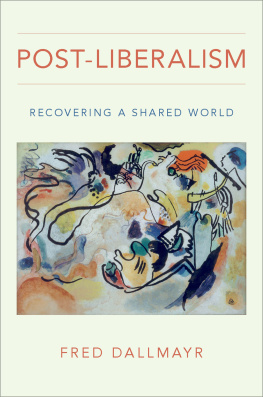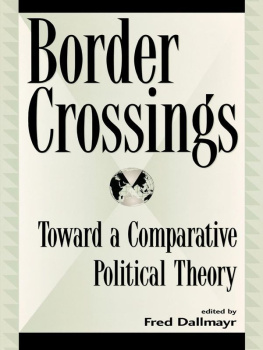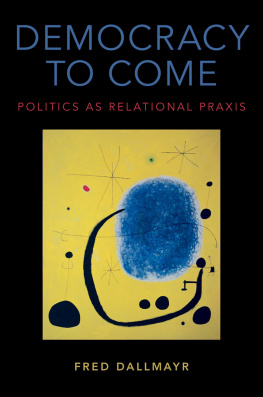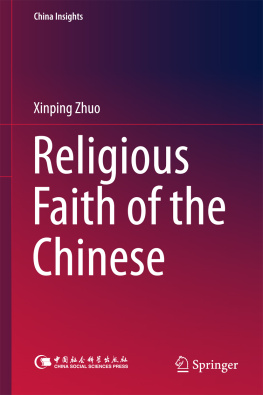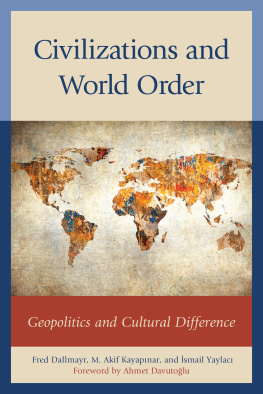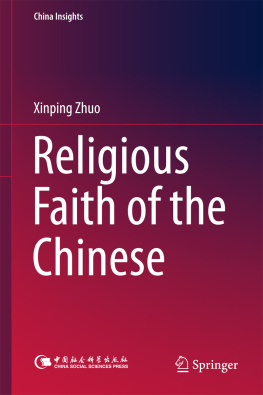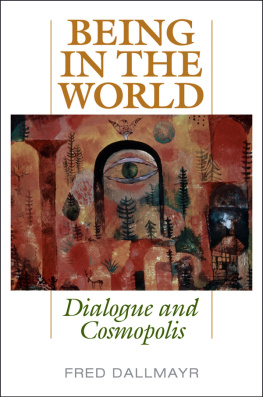Landmarks
Page-list
Horizons of
Difference
Horizons of
Difference
ENGAGING WITH OTHERS
FRED DALLMAYR
UNIVERSITY OF NOTRE DAME PRESS
NOTRE DAME, INDIANA
University of Notre Dame Press
Notre Dame, Indiana 46556
Copyright 2020 by the University of Notre Dame
All Rights Reserved
Cover art: Marc Chagall, Autour delle, 1945 (detail)
(Oil on canvas, 131 x 109,5 cm, at Centre Pompidou, Paris)
2020 Artists Rights Society (ARS), New York / ADAGP, Paris.
CNAC/MNAM/Dist. RMN-Grand Palais / Art Resource, NY
Published in the United States of America
Library of Congress Control Number: 2020940632
ISBN: 978-0-268-10849-6 (Hardback)
ISBN: 978-0-268-10850-2 (Paperback)
ISBN: 978-0-268-10852-6 (WebPDF)
ISBN: 978-0-268-10851-9 (Epub)
This e-Book was converted from the original source file by a third-party vendor. Readers who notice any formatting, textual, or readability issues are encouraged to contact the publisher at
To the memory of Jacques Maritain (18821973),
visionary of a just and humane democracy,
and of Hans-Georg Gadamer (19002002),
practitioner of hermeneutics and of an other humanism
The essential is the difference (Unter-schied) as such;
neither (worldly) beings nor Being suffice to capture this difference.
Martin Heidegger, Vier Hefte
The rift between Being and beings is the reticence
of an original belonging together.
Martin Heidegger, Beitraege zur Philosophie (Vom Ereignis)
CONTENTS
PREFACE
It is a melancholy experience when, at an advanced age, one finds the world hell-bent on proving one wrong. I am now in the ninth decade of my life, and everywhere things seem to be falling apart. Wherever one turns, one finds hateful or vitriolic language, a likely prelude to hateful and destructive deeds. Here are some recent words of the secretary-general of the United Nations Antnio Guterres: States are seeking security, not in the proven collective way of diplomacy and dialogue, but in developing and accumulating new weapons. And the situation is particularly dangerous as regards nuclear weapons.... We simply cannot afford to return to the unrestrained nuclear competition of the darkest days of the Cold War. Yet, notwithstanding these sober words, the return is already well underway.
For me, the situation recalls the earliest days of my life. Living in Germany, my childhood was spent under the dark clouds of the Hitler regime and the disasters of World War II. In my minds eye, I still see burning or devastated cites, the result of firebombing or direct military action. I still see dead or mutilated bodies and long lines of starving people. Later in my life, I also visited the aftermath of utter destruction in cities such as Hiroshima and Nagasaki. But I also recall, after the end of the war, the massive upsurge in my generation of the fervent counterplea: Never again! Never again this descent into bloodlust, into xenophobia and chauvinism, into inhuman hatred and destruction. What gripped my generation then, not only in Germany but in many parts of Europe and the world, took deep roots in own my heart and mind. Indeed, the fervent plea of Never again! became the dominant leitmotif for the rest of my life. Both my actions and the long list of my publications testify to this commitment.
In this book I have assembled a fair number of my writings linked together by the Never again! plea. Some of these writings are new, some are older and have been published before. I have assembled these texts in order to demonstrate that dialogue and multiple peaceful engagements are, for me, not a sudden or occasional inspiration but have served as basso continuo throughout the many decades in my life. I should add that dialogue, for me, is not a restricted or ephemeral enterprise, but it extends broadly to the most important domains of experience: philosophical, cultural, religious, ethical, and political. One dimension that is too often neglected in modern times is the dialogue between religious and secular commitments, between faith and reason. This aspect, it seems to me, is particularly important in our time since both faith and reason can give rise to dangerous and destructive types of extremism, fanaticism, or idolatry. The same interactive engagement also operates within religious traditions: there is insufficient dialogue between and among Catholics, Protestants, and Orthodox Christians, as there is between Sunni and Shia Muslims. Some purely secular ideologies also tend to operate like religious zealotry, especially capitalism and socialism. In all these areas, Never again has been my persistent motto.
So, after having spent my life dedicated to this plea, it is sad to note that the storm signs of our time seem to point back to my beginnings. What kind of delusion possesses people when they long back to a time of hatred, carnage, and destruction? Contrary to the promise of security held out by political and military leaders, why would they want to plunge headlong into mayhem and disaster? Would it not be high time to abandon the reckless machismo of these so-called leaders, not in order to jettison politics altogether, but to listen again to the good news of genuine religion and also the genuine political teachings of Plato and Aristotle (and Gandhi and Confucius)? Clearly, these legacies are meant to serve not just as ornaments decorating schoolrooms or sanctuaries, but, rather, their real significance emerges only when they are confronted with the agonies and ordeals of real-life human sufferings.
When invoked in these lived situations, the legacies surface as brightly shining guideposts illuminating our human existence. Another bright beacon or guidepost is the realm of art, especially music and painting. I have chosen as cover for this book An Undying Love: Around Her by Marc Chagall. As the painting shows, in a genuine loving engagement, everything around the beloved is transfigured into beauty, harmony, and peace.
Fred Dallmayr
University of Notre Dame
October 2019
Postscript: Since the above lines were written, the world has been gripped by a vast health pandemic. In a broad sense, this pandemic has produced two main consequences: first, a further tightening of national boundaries; and second and unexpectedly (despite the policy of social distancing) sporadic upsurges of interhuman solidarity.
ACKNOWLEDGMENTS
Some material in this book has been previously published in different forms. I have drawn from the following sources:
After Babel: Journeying toward Cosmopolis, in Being in the World: Dialogue and Cosmopolis (Lexington: University Press of Kentucky, 2013), 47-58.
Apophatic Community: Yannaras on Relational Being, Comparative Philosophy 10 (January 2019): 3-17.
Befriending the Stranger: Beyond the Global Politics of Fear, Journal of International Political Theory 7 (2011): 1-19.
Confucianism and Public Life: Five Relations Plus One, Dao: A Journal of Comparative Philosophy 2 (June 2003): 193-212.
Gandhi and Islam: A Heart and Mind Unity, in Peace Talks: Who Will Listen? (Notre Dame, IN: University of Notre Dame Press, 2004), 132-54.
Hermeneutics and International Dialogue: Linking Theory and Practice, Ethics and Global Politics 2 (2009): 23-39.
Self and Other: Gadamer and the Hermeneutics of Difference, Yale Journal of Law and the Humanities 5 (1993): 1-13.
Introduction
A Paradigm Shift?
Charles Pguy once distinguished between two types of historical time: periods and epochs. Interpreting broadly the intent of his distinction, one can say that periods are basically times of normalcy, times when things are running or conducted along established routines. Epochs, on the other hand, are times of trouble, when routines are changed or disrupted and when novel vistas (suddenly or haltingly) open up or make their appearance. Given their disruptive and innovative character, one can also call epochs the times of paradigm shifts when there is change not only in details but in constitutive frameworks or frames of meaning. Judged in terms of this distinction, our time in the twentieth and early twenty-first century is definitely an epoch, a time of paradigm shift. In this respect, our present situation resembles the opening phase of Western modernity (four hundred years ago) when European societies broke loose from the medieval structure of the Holy Empire, a broadly homogeneous, religiously inspired and guided Christian commonwealth.


